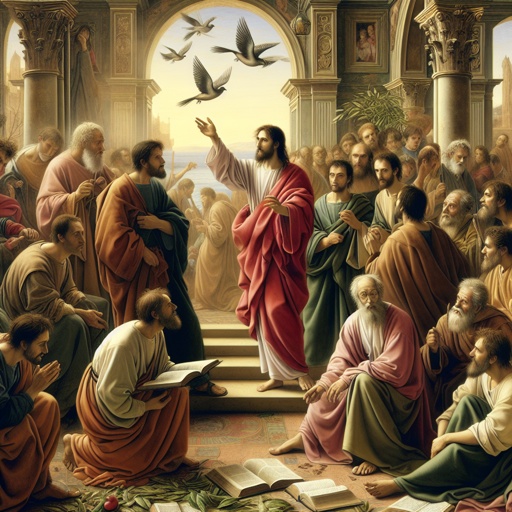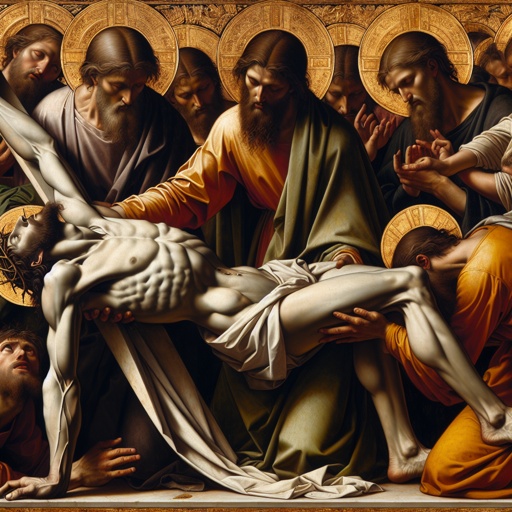What does Mark 16:1 mean?
"And when the sabbath was past, Mary Magdalene, and Mary the mother of James, and Salome, had bought sweet spices, that they might come and anoint him." - Mark 16:1

Mark 16:1 - "And when the sabbath was past, Mary Magdalene, and Mary the mother of James, and Salome, had bought sweet spices, that they might come and anoint him."
Mark 16:1 in the King James Version of the Bible reads, "And when the sabbath was past, Mary Magdalene, and Mary the mother of James, and Salome, had bought sweet spices, that they might come and anoint him." This verse is a part of the resurrection account of Jesus Christ as depicted in the Gospel of Mark.
To understand the significance of this verse, it is important to consider the context in which it is situated. The preceding chapters of Mark narrate the crucifixion of Jesus Christ, His death, and burial. Mark 15:40-47 specifically mentions the women who were present at the crucifixion, including Mary Magdalene and Mary the mother of James. In the Jewish tradition, it was customary to anoint the body of a deceased person with spices and oils. This practice was a symbol of honor and respect for the deceased. In Mark 16:1, it is mentioned that Mary Magdalene, Mary the mother of James, and Salome had bought sweet spices for this purpose.
The verse indicates that these women were committed to properly anointing the body of Jesus, showing their dedication to Him and their sorrow over His death. It also signifies their belief in His physical death, as the custom of anointing was only performed on the deceased.
The theme of faith and devotion is evident in this verse. Despite the grief and confusion that the disciples and followers of Jesus may have been experiencing following His death, these women remained faithful to Him. Their act of purchasing the spices and intending to anoint Jesus' body reflects their commitment to Him even after His death.
Furthermore, the verse highlights the role of women in the life and ministry of Jesus. In a patriarchal society, the actions of these women were significant as they took the initiative to honor Jesus in death. Their obedience to Jewish burial customs and their desire to care for His body demonstrate their deep love and reverence for Him.
Symbolically, the sweet spices represent the fragrant offering of the women's love and devotion to Jesus. They symbolize the purity of their motives and the sweetness of their loyalty to Him. Additionally, the act of anointing foreshadows the revelation of Jesus' resurrection. While the women intended to anoint His body, they would soon discover that He had risen from the dead, and there was no need for them to perform this final act of love and respect.
This verse also serves as a prelude to the resurrection account that follows in the subsequent verses of Mark 16. By mentioning the purchase of the sweet spices, it sets the stage for the remarkable event of Jesus' resurrection, which is the cornerstone of the Christian faith. The act of anointing was ultimately unnecessary because Jesus had conquered death, fulfilling His promises to His disciples and affirming His divinity.
In conclusion, Mark 16:1 encapsulates the themes of faith, devotion, and the pivotal moment of Jesus' resurrection. The actions of the women and the symbolism of the sweet spices all contribute to the profound significance of this verse within the broader narrative of the Gospel of Mark. It serves as a reminder of the unwavering commitment of Jesus' followers and foreshadows the awe-inspiring revelation of His triumph over death.
Mark 16:1 Artwork

Mark 16:1 - "And when the sabbath was past, Mary Magdalene, and Mary the mother of James, and Salome, had bought sweet spices, that they might come and anoint him."

Mark 16:1-8 - "When the Sabbath was over, Mary Magdalene, Mary the mother of James, and Salome bought spices so that they might go to anoint Jesus’ body. Very early on the first day of the week, just after sunrise, they were on their way to the tomb and they asked each other, “Who will roll the stone away from the entrance of the tomb?” But when they looked up, they saw that the stone, which was very large, had been rolled away. As they entered the tomb, they saw a young man dressed in a white robe sitting on the right side, and they were alarmed. “Don’t be alarmed,” he said. “You are looking for Jesus the Nazarene, who was crucified. He has risen! He is not here. See the place where they laid him. But go, tell his disciples and Peter, ‘He is going ahead of you into Galilee. There you will see him, just as he told you.’” Trembling and bewildered, the women went out and fled from the tomb. They said nothing to anyone, because they were afraid."

Mark 16:20

Mark 16:20

Mark 16:20

Mark 16:20

Mark 16:20

Mark 3:16 - "And Simon he surnamed Peter;"

Mark 1:16 - "Now as he walked by the sea of Galilee, he saw Simon and Andrew his brother casting a net into the sea: for they were fishers."

Mark 9:16 - "And he asked the scribes, What question ye with them?"

Mark 16:13 - "And they went and told it unto the residue: neither believed they them."

Mark 7:16 - "If any man have ears to hear, let him hear."

Mark 16:4 - "And when they looked, they saw that the stone was rolled away: for it was very great."

Mark 8:16 - "And they reasoned among themselves, saying, It is because we have no bread."

Mark 16:10 - "And she went and told them that had been with him, as they mourned and wept."

Mark 16:11 - "And they, when they had heard that he was alive, and had been seen of her, believed not."

Mark 11:16 - "And would not suffer that any man should carry any vessel through the temple."

Mark 13:16 - "And let him that is in the field not turn back again for to take up his garment."

Mark 15:16 - "And the soldiers led him away into the hall, called Praetorium; and they call together the whole band."

Mark 16:12 - "¶ After that he appeared in another form unto two of them, as they walked, and went into the country."

Mark 5:16 - "And they that saw it told them how it befell to him that was possessed with the devil, and also concerning the swine."

Mark 16:2 - "And very early in the morning the first day of the week, they came unto the sepulchre at the rising of the sun."

2 Timothy 3:16

Mark 1:1 - "The beginning of the gospel of Jesus Christ, the Son of God;"

Mark 16:3 - "And they said among themselves, Who shall roll us away the stone from the door of the sepulchre?"

Mark 12:16 - "And they brought it. And he saith unto them, Whose is this image and superscription? And they said unto him, Caesar's."

Mark 16:15 - "And he said unto them, Go ye into all the world, and preach the gospel to every creature."

Revelation 16:2

Mark 16:15-16 - "And he said unto them, Go ye into all the world, and preach the gospel to every creature. He that believeth and is baptized shall be saved; but he that believeth not shall be damned."

Mark 10:16 - "And he took them up in his arms, put his hands upon them, and blessed them."